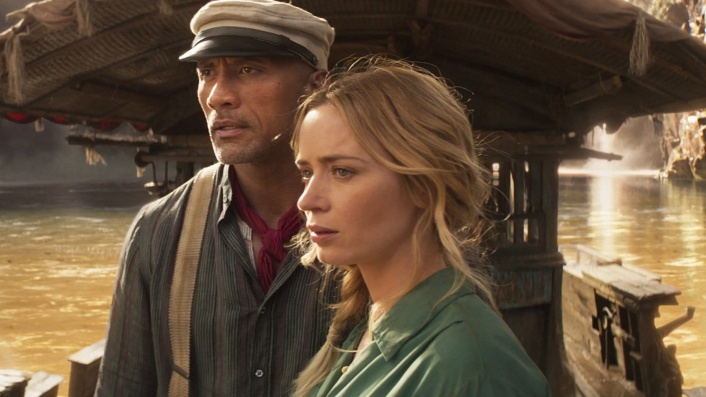Jungle Cruise is what you’d expect from a movie based on a cheesy theme park ride
Dwayne Johnson and Emily Blunt sail the Amazon in a chaotic but vanilla SFX-filled adventure.

Dwayne Johnson and Emily Blunt sail down the Amazon in search of the Tree of Life in Disney’s chaotic but vanilla SFX-filled adventure. Here’s Luke Buckmaster’s review.
In his famous takedown of the Marvel Cinematic Universe, Martin Scorsese rallied against the monolithic blockbuster franchise for spitting out productions he described as “closer to theme parks than they are to movies.” Saying the same about Disney’s wishy-washy and pseudo exotic adventure Jungle Cruise would be less an expression of opinion than a statement of fact: it was adapted—though that word implies a rigorous conversion process—from an attraction at Disneyland launched in the 1950s.
See also:
* Movies now playing in cinemas
* All new streaming movies & series
During this ride, patrons sit on a plasticky-looking boat that snakes down a simulation of the Amazon, past a mixture of animatronic animals and statuettes. Many are frozen, petrified in time—as if occupying land cursed by a far-flung taxidermist—but some of the lucky ones have basic movement, such as elephants with trunks that go up and down. It looks like one of those rides you go on because the line is short, or your stomach can’t handle another rollercoaster.
There’s some evidence of self-referentialism in director Jaume Collet-Serra’s chaotic but vanilla-flavoured movie, set in Brazil in 1916. When we meet Dwayne Johnson’s character Frank Wolff we discover he’s a steamboat captain who takes passengers for a ride in more than one sense. Wolff is a showman, a charlatan, a trickster, who has arranged the experience as a kind of staged pageant, with things that pop out at particular times and a group of friends pretending to attack the boat. This is accompanied by a refined banter-filled commentary (like the real-life ride) and, as we soon learn, he even has a sweetie-pie pet jaguar trained to pretend to be menacing.
But, weirdly, Frank is also an actual captain with amazing skills. He can navigate his clunky boat through raging rapids away from the edge of precipitous waterfalls, for instance, just in the nick of time and barely raising a sweat, and survive perilous jungle scenarios no-problemo. Screenwriters Michael Green, Glenn Ficarra and John Requa—working from their, shall we say, experiential source material—want to give him the colourful flakiness of an ingenious swindler (sans the moral deficiencies that make these characters interesting) but also the survival skills of Tarzan and He-Man.
They make the point that plucky British scientist Dr. Lily Houghton (Emily Blunt) didn’t know what she was getting into when she selected Frank as the captain for her expedition, without suggesting she chose poorly. Lily’s mission is to find the Tree of Life—or the “healing tears of legend,” as the narrator describes it—which she believes will transform the world of medicine. I like to think the real deal is also located in Disneyland: that the sacred sapling, the fountain of youth, the elixir of the gods has been with us all along, hidden in a shitty theme park ride, over the fence from the hotdog stand.

What could have been a snappy hour and a half lark runs for a galumphing 127 minutes. The experience tends to improve a little when Jesse Plemons rears his head as a shit-eating German bad guy, determined also to get to the tree of life, travelling in a more impressive vessel—a submarine—than Lily and Frank, who share a familiar trajectory, from frostiness to (restrained) sexual tension. “Who brings a submarine to the Amazon?” asks the hulkish captain, the writers again demonstrating a modicum of self-awareness in a film otherwise averse to the idea that there is anything beneath the surface.
There are several narrative resets and moments when you can spot the joins: a context-explaining intro, for instance; a chunk of voice-over articulating an important backstory; and the introduction (about halfway through) of an additional heap of colourful crud, with wacky creatures and supernatural characters springing out of the CCG-slathered woodwork. One of them is a fantastically creepy villain with a beard of special effects—snakes slithering around his chin, positioned in lieu of his facial hair, like Davy Jones’ tentacles.
Until that point, I had been slowly coming to appreciate Jungle Cruise’s greatest strength: the sheer visuality of it. Collet-Serra’s picture book aesthetic, with sun ensconcing the characters in gluggy golden light and colours of the jungle arranged like hues from hard-boiled lollies, is undeniably pretty, with that familiar soundstage surrealness. Spatial movement through this environment is choreographically straightforward, arranged in such a way as to make it clear at all times where everybody is in relation to the anchoring frame of reference—the steamboat.
There is a sense of visual clarity: you could turn the volume off and still have a perfectly good understanding of the plot—an appealing feature for a film marketed at families, though not exactly evidence of a compelling storyline or captivating dialogue. Collet-Serra doesn’t trust his cast, his writers, his setting, his choreography to tell this story, nor his sense of adventure to enliven it, so he overloads the film with visual gibberish, creating a paradoxical combination—colourful surfaces, bland tone and temperament.
Disney has been pumping this stuff out for eons: the risk-averse play-to-the-back-rows ‘Saturday matinee’ movie popular at the time of release, but destined to quickly recede into cultural oblivion. The theme park ride will probably leave a greater impression on patrons—and, at eight minutes long, has a vastly more palatable running time.






















